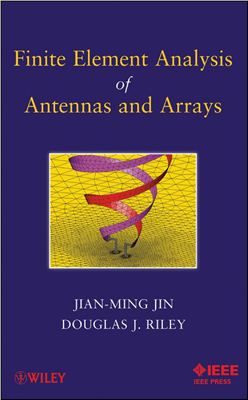John Wiley & Sons, Inc., 2009. – 467 pages.
The book is organized into 12 chapters. In Chapter 1 we describe the need for numerical simulation in the design of complex antennas and arrays and compare the ?nite element method with other numerical techniques from the viewpoint of antenna analysis. Chapter 2 covers the formulations of ?nite element analysis of antennas in the frequency and time domains. Chapter 3 deals with the problemofmesh truncation in the ?nite element analysis of antennas. In Chapter 4 we describe a hybrid technique that combines the ?nite element time-domain method with the ?nite-difference time-domain method. Chapter 5 deals with the critical problem of modeling antenna feeds for radiation analysis and plane-wave excitation for scattering analysis. In Chapter 6 we consider the ?nite element modeling of complex structures and circuit components that are widely used in antenna designs. In Chapter 7 we present a variety of antenna simulation examples to demonstrate the capability and versatility of the ?nite element method. Chapter 8 covers the analysis of axisymmetric antennas using a two-dimensional ?nite element method. The modeling of in?nitely large phased arrays is the topic of Chapter 9, which covers both the frequency- and time-domain analyses. In Chapter 10 we present various domain-decomposition techniques for the analysis of large ?nite arrays, which is one of the most challenging problems for computational electromagnetics. Chapter 11 deals with another challenging problem, which is modeling of antenna–platform interactions by combining the ?nite element method with other numerical or asymptotic techniques. Finally, in Chapter 12 we discuss various numerical and practical considerations in the ?nite element analysis of antennas and arrays.
The book is organized into 12 chapters. In Chapter 1 we describe the need for numerical simulation in the design of complex antennas and arrays and compare the ?nite element method with other numerical techniques from the viewpoint of antenna analysis. Chapter 2 covers the formulations of ?nite element analysis of antennas in the frequency and time domains. Chapter 3 deals with the problemofmesh truncation in the ?nite element analysis of antennas. In Chapter 4 we describe a hybrid technique that combines the ?nite element time-domain method with the ?nite-difference time-domain method. Chapter 5 deals with the critical problem of modeling antenna feeds for radiation analysis and plane-wave excitation for scattering analysis. In Chapter 6 we consider the ?nite element modeling of complex structures and circuit components that are widely used in antenna designs. In Chapter 7 we present a variety of antenna simulation examples to demonstrate the capability and versatility of the ?nite element method. Chapter 8 covers the analysis of axisymmetric antennas using a two-dimensional ?nite element method. The modeling of in?nitely large phased arrays is the topic of Chapter 9, which covers both the frequency- and time-domain analyses. In Chapter 10 we present various domain-decomposition techniques for the analysis of large ?nite arrays, which is one of the most challenging problems for computational electromagnetics. Chapter 11 deals with another challenging problem, which is modeling of antenna–platform interactions by combining the ?nite element method with other numerical or asymptotic techniques. Finally, in Chapter 12 we discuss various numerical and practical considerations in the ?nite element analysis of antennas and arrays.

